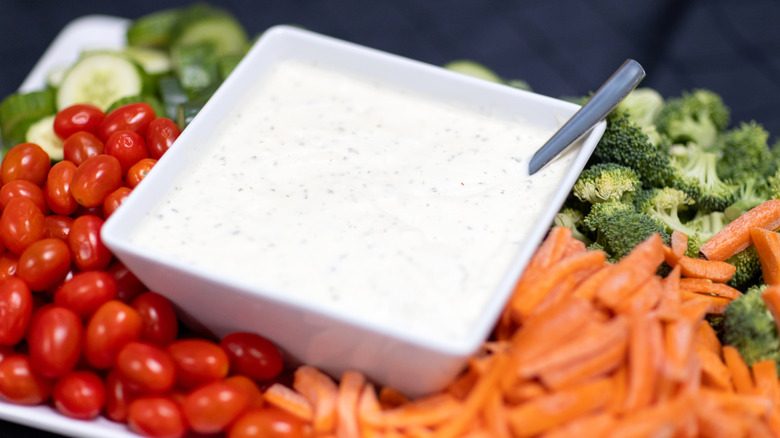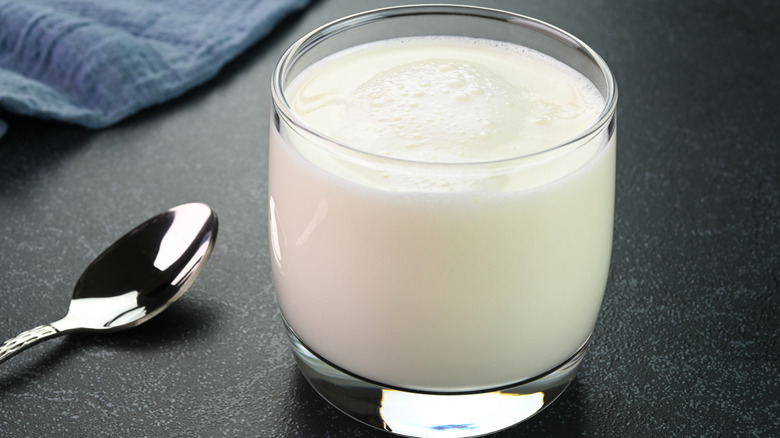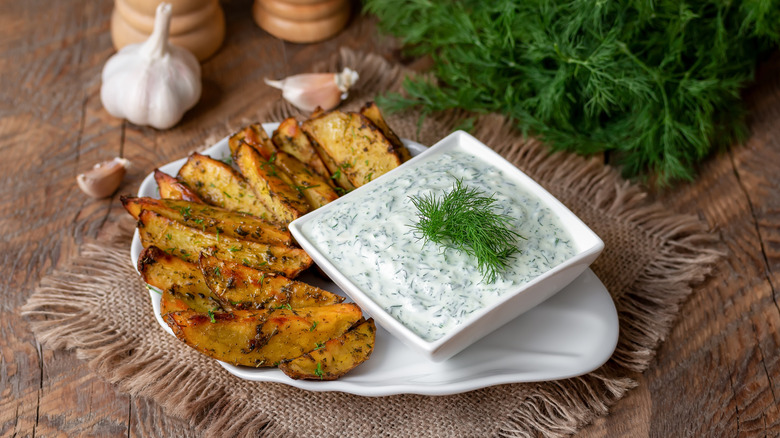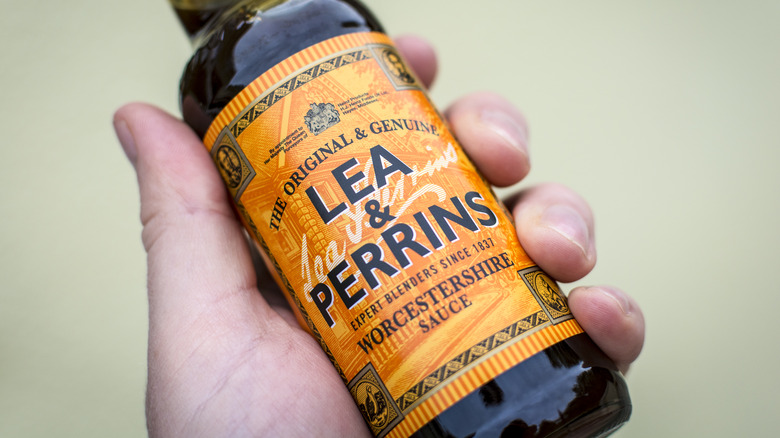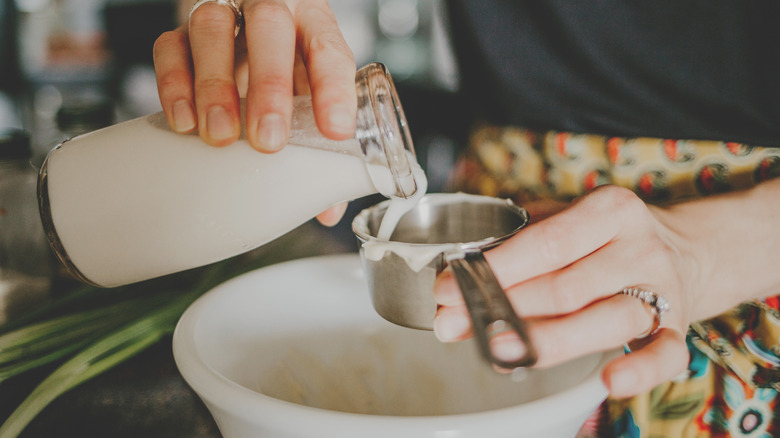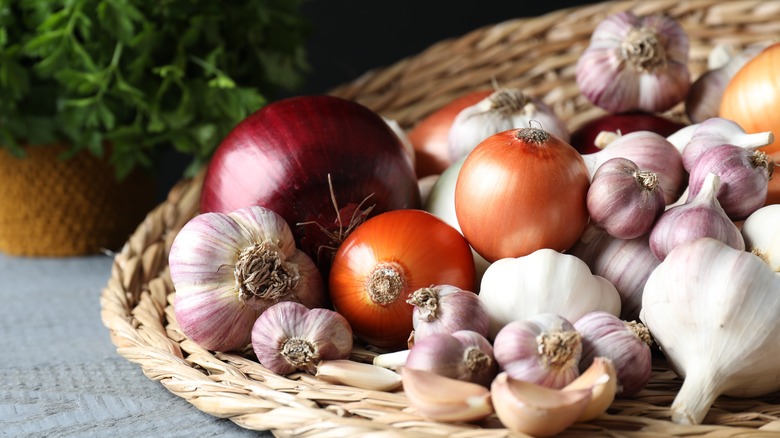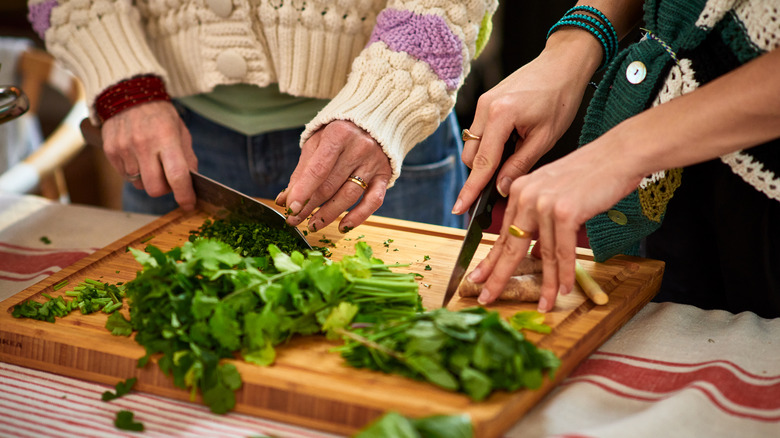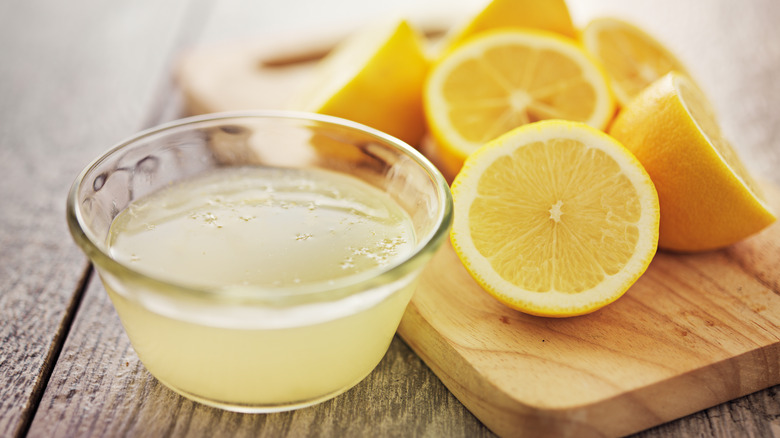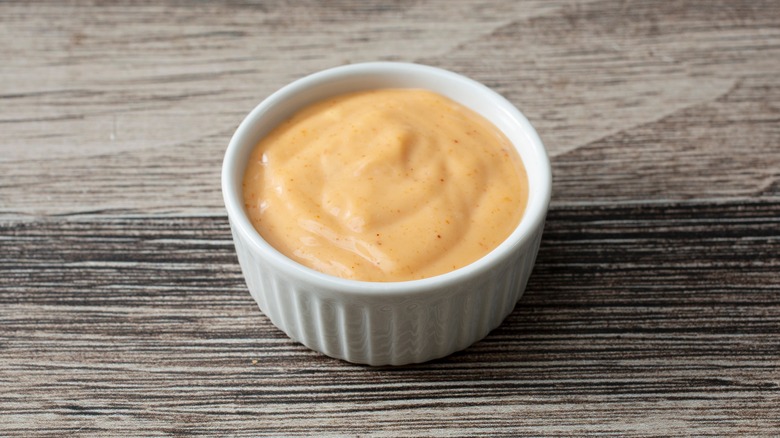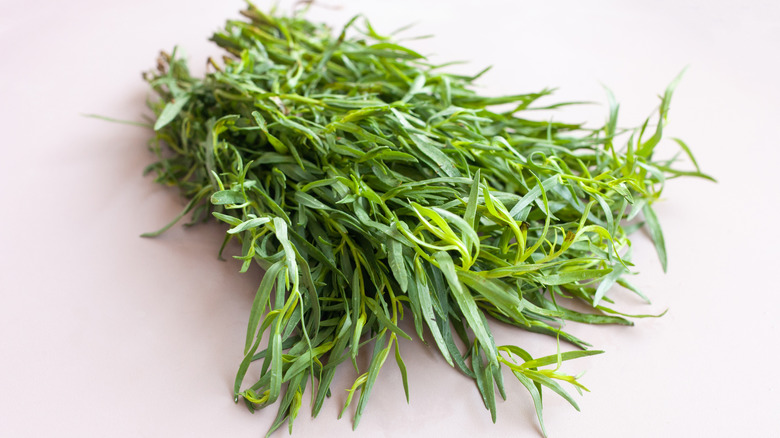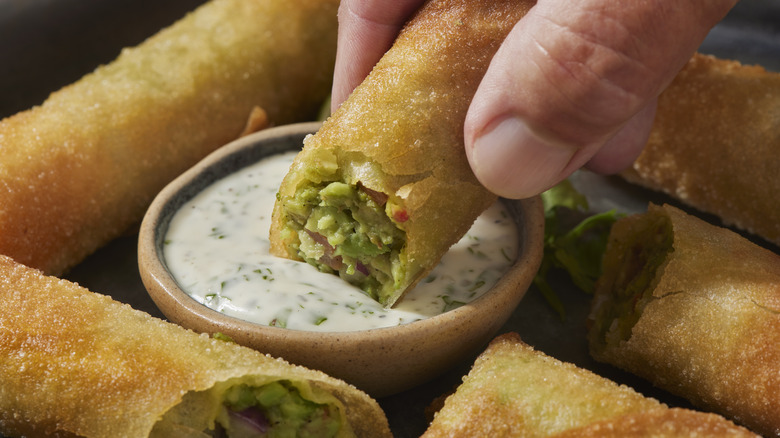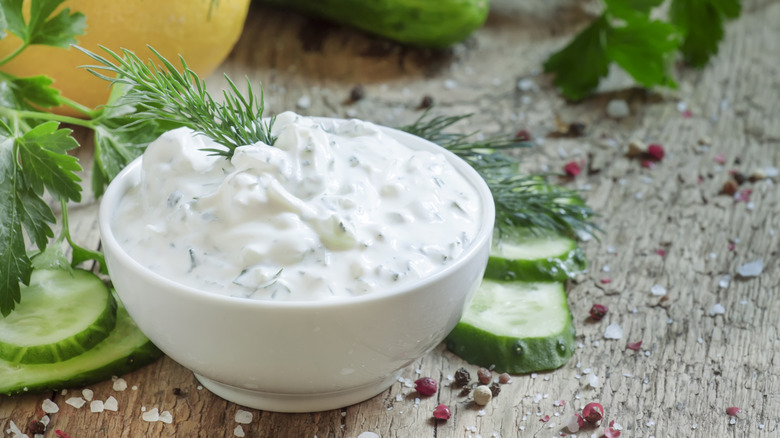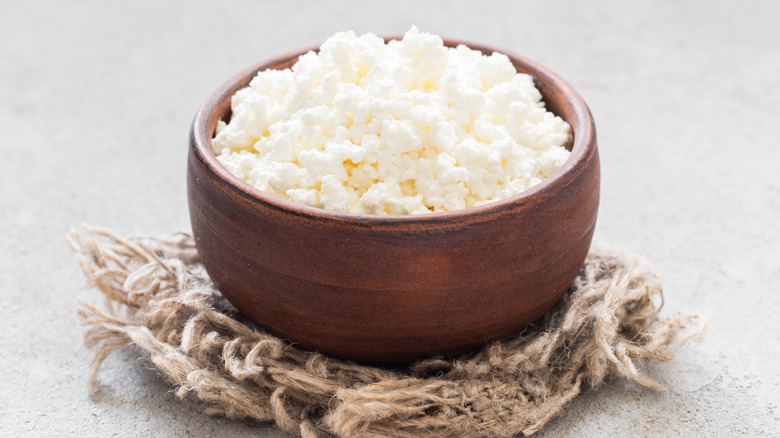Mistakes Everyone Makes With Homemade Ranch Dressing
It's no secret: everybody loves ranch. But sometimes, homemade versions just don't live up to your restaurant favorites. Whether your favorite ranch is from a bougie local independent restaurant or a chain diner, when you recreate it at home, it might not be the same as you expected. Don't worry, though — you're not alone. There are all kinds of common mistakes people make with homemade ranch dressing.
Although it seems simple — creamy and packed with herbs — there's a lot of nuance that goes into the perfect ranch. Some folks neglect the Holy Trinity of creamy ingredients: buttermilk, sour cream, and mayo, leaving out the buttermilk or sour cream. Others don't make it tangy enough, not realizing it might benefit from some extra acidic ingredients. All these missteps and more can lead to a disappointing ranch dressing.
There's also the issue of preference. Certain ingredients might make a technically better ranch dressing, but it doesn't mean you're going to prefer them. If your favorite version is made with a powdered mix, fresh ingredients might not taste quite right. Still, once you know where everyone goes wrong with this classic dressing, you can learn how to fix or avoid these errors. And you might just make the best ranch of your life while you're at it.
Leaving out the buttermilk
While there are variations, the creaminess of a classic ranch comes from three ingredients: sour cream, mayonnaise, and buttermilk. Some people leave out the buttermilk, but this is generally considered incorrect. It's part of what gives ranch its signature flavor. Plus, it helps with getting the right texture.
Buttermilk is a tangy, liquid traditionally made as a byproduct of churning butter. These days, it's usually cultured, meaning milk is fermented with lactic acid bacteria to give it that signature tart flavor and creamy texture. Some people think you can leave the buttermilk out because the versions sold today aren't true buttermilk. While it's true that it doesn't come from the butter-making process, it still has the same flavor and works the same in recipes — your dressing doesn't care where it came from.
What buttermilk does in ranch is make it extra tangy. Sure, some of that acidic flavor comes from the sour cream, but you need a double dose to get a true ranch taste. What's more, buttermilk helps thin the dressing. Without it, you'll be left with a dip thick enough to have a carrot stick stand up in it. This might be fine for some uses, but if you want a thinner ranch as a dressing or drizzle, buttermilk helps achieve this consistency. You can add more or less of it to get a thinner or thicker dressing.
Using dried herbs
If you're used to buying ranch in a bottle, you're probably familiar with the dried herb flavor, but for the tastiest results, fresh herbs are the way to go. Forget about the dusty canisters of dill and parsley in the back of your pantry. You should reach for fresh herbs and lots of them for more flavor.
The trouble with dried herbs is that they're inconsistent. Some taste fairly similar to their fresh counterparts. Dill is a good example of this. Dried dill doesn't have quite the nuance of the fresh stuff but it's close. Dried parsley, on the other hand, tastes like a sad reflection of fresh. It's like someone dunked parsley in water and then dried the water. There's also variation in the potency of dried herbs depending on how fresh they are, which can throw off the results. Opting for fresh herbs is always your best bet and will result in a better ranch.
You need around 6 tablespoons or a generous handful of diced tender fresh herbs. The exact amount isn't set in stone, so you can increase or decrease this according to your preferences. Mix them in with the other ingredients, and you have yourself ranch dressing. It's really that simple.
The one potential issue with using fresh herbs is that some people are so used to dried ones in this dressing that they actually prefer them. So, while we recommend trying fresh herbs to start with, if you find your ranch doesn't have the exact flavor you want, give the dried versions a shot.
Not considering Worcestershire sauce as an ingredient
Worcestershire sauce is the secret ingredient that takes ranch dressing to the next level. It might sound like an odd addition to this classic dip but bear with us. It actually brings a lot to the table and you don't need much of it.
For those not in the know, Worcestershire sauce is a tangy condiment with a complex flavor that's hard to describe. It's made by fermenting ingredients like malt vinegar, molasses, anchovies, tamarind, and spices. It adds umami-rich depth to ranch dressing. You might not be able to identify the extra ingredient, but you can absolutely notice the difference when tasted side-by-side. There's an extra savoriness to ranch made with Worcestershire sauce and more tang to cut through the creamy ingredients.
You just need around a ½ teaspoon of Worcestershire sauce for an average recipe of ranch. But if you're unsure about the serving size or you're worried about adding too much, start smaller and work your way up. Just be aware that this condiment usually contains fish, so if you're making food for vegetarians, it's not going to fly. There are vegetarian versions of Worcestershire sauce, but they're harder to find.
Using low-fat dairy and mayo
Ranch dressing is supposed to be indulgent and creamy, so it's a mistake to use low-fat versions of its main ingredients. Mayonnaise, sour cream, and buttermilk all have low-fat versions available, but you shouldn't be reaching for them when making ranch. You might get a perfectly nice creamy dressing, but it won't turn out the way that ranch made with full fat ingredients does.
This is because fat carries and enhances flavor. It dissolves and distributes fat-soluble compounds, making it taste richer and more pronounced. Fat also provides a creamy texture that low-fat versions often lack. Ultimately, you'll get a better and more well-rounded flavor from full-fat mayonnaise, sour cream, and buttermilk.
This might mean that ranch isn't an everyday dressing for you and that's okay. A balanced diet can involve some richer and heavier foods alongside some leaner and lower fat options. It doesn't have to be all or nothing. So, reach for those full-fat ingredients when making homemade ranch and eat it in moderation. Isn't it better to eat a smaller amount of something really delicious than piles of something that's just okay?
Overlooking onion and garlic
Buttermilk, mayo, sour cream, herbs — you might think that's pretty much it when it comes to ranch. But, actually, a whole lot of the flavor comes from onion and garlic. This duo of alliums is essential to a tasty dressing, so overlooking them is a big mistake, but one that people commonly make.
If you've thrown together bland ranch in the past, it might be because you didn't use onion and garlic. But, of course, it's an easy one to fix. Quite a lot of classic ranch dressing recipes call for onion and garlic powder. This is what's commonly used in bottled ranch, as well as in restaurant versions that are made using a packet mix. If your favourite ranch is from a chain restaurant or a greasy spoon, it's probably made using powdered onion and garlic, so this might actually be the flavor you prefer.
However, if you're looking to level yours up, consider using fresh onion and garlic. It makes more of a punch, so you should be conservative with it, but it will bring a greater complexity to the finished product. If you want to avoid the powdered stuff but you're worried about raw onion and garlic being too sharp, you can roast the garlic and sauté or caramelize the onion to mellow them out.
Not chopping herbs finely enough
Herbs play a big part in ranch dressing. Being herby is one of its defining features. But when you're using fresh herbs, not chopping them finely enough is a common misstep. We get it, chopping herbs is a chore and it can take a while to achieve fine results. However, you want the dressing to be cohesive and having big pieces of herbs in it can interfere with this. It ends up more like a dressed salad than a dip.
But that's not the only reason to chop herbs this way. It can also make a difference to the way your ranch tastes. Finely chopped herbs are more potent than roughly chopped ones because chopping releases their essential oils, which carry the flavor and aroma. The finer the chop, the more oils are released, resulting in a stronger, more concentrated flavor.
Herbs for your ranch should be finely minced. This might involve going over them a couple of times to get them as small as you need them. It takes some patience, but if you have a reasonably sharp knife, it's easily achievable. Even better if you have a mezzaluna herb chopper, but it's certainly not essential. Another option is to put all the ingredients for your dressing in a food processor and whizz them together. You have to know when to stop so as not to completely purée the herbs, but it can work quite well.
Forgoing lemon juice or vinegar
Making homemade ranch dressing without a splash of lemon juice or vinegar is a mistake. Not all recipes call for it, but the tanginess is what makes ranch so distinct, cutting through the creaminess of the base ingredients like mayo and sour cream. Without an acidic kick, the dressing can taste flat or overly rich. There are several ways to make ranch dressing tangier and more delicious, but this is one of the simplest options.
Adding lemon juice or vinegar accentuates the tang and brings everything together. The acidity balances the fat, sharpens the flavors of the herbs, and enhances the garlic subtle bite. It's that perfect contrast between creamy and tangy that makes ranch what it is. Plus, the acid gives it a fresher, brighter taste that's hard to resist.
Whether you're using lemon juice for a citrusy brightness or vinegar for a deeper, more robust tang, don't skip this step. Even a small squeeze or splash can level up your ranch. There are quite a lot of ingredients in ranch and it can be tempting to skip anything that doesn't seem totally necessary, but we implore you not to forgo the lemon juice or vinegar.
Always sticking with the classic recipe
A classic ranch dressing consists of the creamy ingredients (usually mayo, sour cream, and buttermilk), onion, garlic, herbs, a splash of something acidic, and salt to season it. This is delicious — it's a classic for a reason. Yet, it's a mistake to always stick with this version and never try anything new. There are all kinds of ranch variations out there, and it's worth exploring them.
For instance, the combination of Szechuan peppercorns and fish sauce is a chef-approved addition to this dressing. You get a kick from the peppercorns, and savory fermented notes from the fish sauce. But, there are so many variations. For instance, you can make it spicy by adding hot sauce or chile paste, such as sriracha or gochujang. Or, stir in hot honey to make it sweet and spicy. Adding some pesto to ranch dressing makes it extra herby and savory, while mixing in some mustard gives it a bit of sharpness.
You can make a cheesy version of ranch by crumbling in feta or blue cheese. Dill pickle ranch is another delicious variation — all you need to do is add some finely diced dill pickles or even pickle relish if you don't feel like chopping. There are practically endless ways to enhance this dressing. While it's flavorful, it's fairly versatile and works with a wide range of other ingredients.
Using the same herbs every time
Oddly, there's no real consensus about which herbs should go in ranch dressing. That's a big part of why it can taste quite different from place to place. However, it's generally accepted that a combination of any soft herbs will do the trick. It's a mistake to use the same ones every time — unless you stumble on a combination you love so much you can never go back. Failing to experiment with different herbs and ratios can leave you stuck in a ranch rut, never having your homemade versions reach the heights that they could do if you branched out.
Dill is often the herb everyone thinks about when they're making ranch. It has a fairly assertive, distinctive taste, so it often comes through as the most noticeable addition. If you're looking to make a classic, crowd-pleasing ranch, we'd recommend using at least some dill. However, some people find it overwhelming and prefer to use it in smaller quantities or leave it out all together. Parsley is another common herb for this dressing — ideally, the Italian flat leaf variety. It has a fresh flavor with a light bitterness that adds complexity. Chives are also frequent flyers, with a light allium flavor similar to mild onion and garlic.
But, you don't have to stick with the classics. You might choose to include tarragon for its pungent anise notes or cilantro for its slight citrus flavor. Mint brings a sweet brightness and zing, while basil is savory and aromatic.
Making ranch too thin
It's easy to make ranch dressing too thin. Just a slight mistake with the ratios of ingredients and you have yourself a soup or a savory shake rather than a satisfyingly creamy dressing that you can use as a dip for everything from wings to celery sticks. But, of course, the perfect thickness for your dressing really depends on your preference and what you're using it for.
For instance, the base ingredients Rachael Ray uses for ranch dressing are Greek yogurt or sour cream. She doesn't like using buttermilk and mayonnaise because she believes they make it too thin. But Ray likes her ranch to be more of a dip than a dressing, perfect for dipping fries, nuggets, and more. Greek yogurt gives you the tang that you want from a ranch dressing, but can be too obviously yogurt-tasting when used on its own. We prefer sour cream or, if you must, a combination of Greek yogurt and sour cream.
Still, you don't have to forgo mayo and buttermilk to get thick ranch. You can still make it a spoonable thickness with these ingredients added and you get more of a classic ranch flavor. Play around with your ratios until you reach the consistency you want. You may need to use a little less buttermilk or add slightly more sour cream than a recipe calls for. However, sometimes you want a fairly thin ranch for drizzling over dishes or dressing salads. It's all about getting the right balance.
Not giving it some resting time
Using your ranch as soon as you've finished mixing it is a common mistake. We get it — you want to enjoy the fruits of your labor as soon as possible. But giving it some time to rest will improve it. Patience pays off here; it really is worth the wait.
Resting your ranch gives the flavors time to settle and meld. It also lets the herbs soften slightly, so they're more pleasant to eat. When you use it right away, you'll get pops of garlic and herbs only when you're eating parts that contain those ingredients. But, after a while, those flavors infuse through the whole dressing, giving it a more consistent flavor throughout. If you're using fresh garlic, it will also have some time to mellow so it isn't as sharp as when you first mixed up the ingredients.
Ideally, you should rest ranch dressing for two hours before serving. But, we understand that it can be hard to plan this far ahead. Even a 30 minute rest will make a difference to the flavor. On the other hand, if you're feeling super organized, whip it up well ahead of time. It keeps well, lasting for up to two weeks in the fridge in an airtight container.
Ignoring the option to make a cottage cheese variation
Cottage cheese hasn't always been seen as the most exciting food but it's had a resurgence in recent years. It's popped up everywhere — even in ranch. You heard us right, this dressing has received the cottage cheese treatment. Maybe that seems odd but the TikTok trend for cottage cheese ranch is way more delicious than it sounds. Ignoring it as an option when making this dressing from scratch is a mistake.
But, what does this trend entail exactly? Effectively, it's just cottage cheese blended up with a packet ranch mix. This is perhaps one of the easiest ways of making your own ranch, but it's possible to put together a more homemade version. You can use blended cottage cheese in place of buttermilk, mayo, and sour cream but still add your own fresh herbs, onion, garlic, and so on.
Cottage cheese has a rich texture and a decent amount of tang to it, so it tastes great in ranch dressing. Some people add extra ingredients, such as pickle juice for more tang and extra dill flavor. Ultimately, it's fairly adaptable, so you can play around with it as you see fit.
